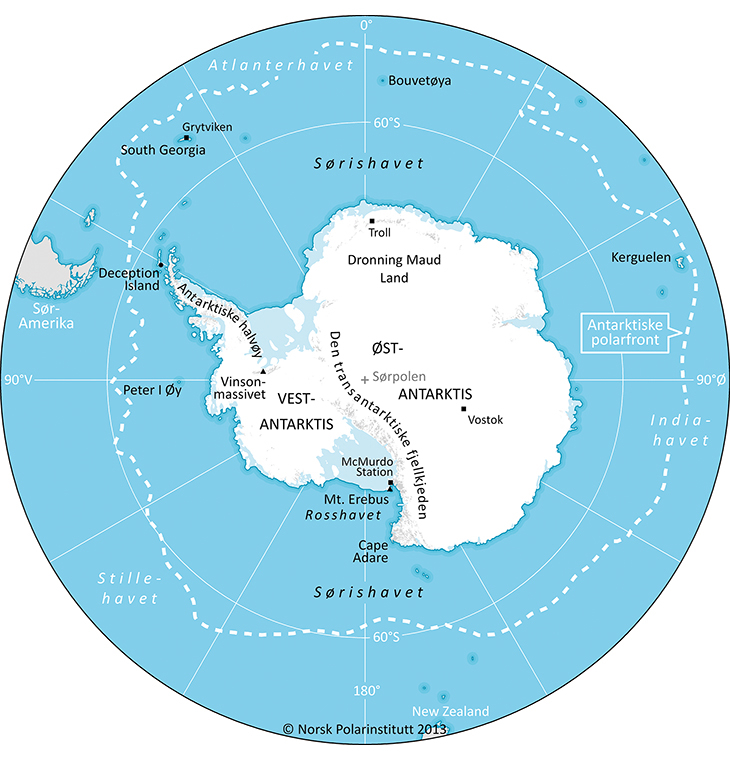1 Introduction
Norwegian Antarctic policy has been centred on the assertion of Norwegian sovereignty claims and on the furtherance of international cooperation to ensure peaceful development of the Antarctic region. This policy has remained consistent for many years. However, no full-scale review of Norway’s policy in the Antarctic has previously been undertaken, so no white paper or other comprehensive report has been issued that sets out the policy framework. At a time of growing interest and activity in the Antarctic by actors from Norway and other countries, the Government has concluded that a broad-based presentation of developments in the Antarctic and of Norwegian interests in the region is needed. The aim of this white paper is to explain Norway’s key policy considerations in the Antarctic and what the policy should be in the years ahead.
Background
Norway has long traditions as a polar nation, both in the north and the south. Norwegian Antarctic history reflects the country’s yearning for discovery, its scientific curiosity, its business interests and its political engagement since the 1890s to the present day. But Norway’s Antarctic history is not only the story of Norwegian activity in the Antarctic. It is also the story of Norway as a key player in the development of the international cooperative regime for the Antarctic region.
Norway claims substantial territories in the Antarctic: Dronning Maud Land and Peter I Øy. Pursuant to the Antarctic Treaty, the territorial claims remain fixed for as long as the Treaty is in force. No party to the Treaty can be deemed to have renounced its claims; nor can any new claims be made on the basis of activities taking place while the Treaty is in effect. The Antarctic Treaty has also given rise to several other international agreements, which – in combination with the Treaty itself – are often referred to as the Antarctic Treaty System. Norway plays an active role in international collaboration associated with the Antarctic Treaty, including the Protocol on Environmental Protection to the Antarctic Treaty (the Environment Protocol) and the Convention the Conservation of Antarctic Marine Living Resources (the CAMLR Convention).
The international cooperation that has occurred under the Antarctic Treaty of 1 December 1959 has largely been successful. It has kept an entire continent outside the fluctuations of world politics, and has made possible an unprecedented level of international scientific cooperation while laying the groundwork for a joint commitment by the treaty parties to extensive environmental protection. The cooperative approach has worked so well because all parties have seen it as being in their interest to reach common solutions.

Figure 1.1 Map of the Antarctic.
Source Norwegian Polar Institute.
Norway has a long history as a research nation and industrial actor in and around Antarctica. Today the country operates a year-round research station (Troll) in Dronning Maud Land and sends frequent research expeditions into the waters around Antarctica. Norwegian companies, meanwhile, fish in those waters, operate tours as part of the Antarctic travel industry and supply satellite downlink services from Troll.
Norwegian Antarctic policy has remained constant over a long period of time. It is focused deliberately on Norway’s special interests as a claimant, while striving for solid, effective international collaboration, especially under the umbrella of the Antarctic Treaty. Norway has played a central role in this Treaty’s collaboration and has worked hard to develop effective solutions for management of the area covered by the Treaty. Norway was active, for example, in the talks that led to the Antarctic Treaty’s Environment Protocol. Norwegian Antarctic policy emphasises the core values that underpin the international partnership in the region – peace, scientific research and environmental protection.
Since there has been no previous strategic review of Norway’s Antarctic policy, there is no existing white paper or comprehensive document that outlines the country’s policy framework for the region. Yet we have entered a time when more and more actors are reporting an interest in pursuing activities in the Antarctic. Because of the increased diversity of actors and activities, the Antarctic Treaty System agenda has grown in breadth and complexity. This white paper is about Norwegian policies and Norwegian interests within the scope of the Antarctic Treaty System, which includes the Norwegian dependencies of Dronning Maud Land and Peter I Øy. The third Norwegian dependency, Bouvetøya, lies north of the Antarctic Treaty’s area of application. Bouvetøya is undisputed Norwegian territory. The Government has found it appropriate to submit a separate white paper on Bouvetøya. In this report, therefore, Bouvetøya will be discussed only to the extent that it directly pertains to issues affecting Norwegian interests in the Antarctic.
Objectives
The purpose of this white paper is to increase awareness of what it means for Norway to be a polar nation in the south. The Government aims to present an overall view of Norwegian interests and Norwegian policies, so that this document can serve as both a political administrative document and a source of information for the broader public.
Norway’s Antarctic policy is intended to provide guidance and operating parameters for the following:
Safeguarding the interests of Norway as a claimant state.
Fulfilling international obligations, especially those related to the Antarctic Treaty, the treaty’s Environment Protocol and the CAMLR Convention.
Norway’s cooperative role under the Antarctic Treaty system.
Increasing synergy where relevant between Antarctic expertise and Arctic expertise – as regards climate change, for example.
Sustainable Norwegian business interests.